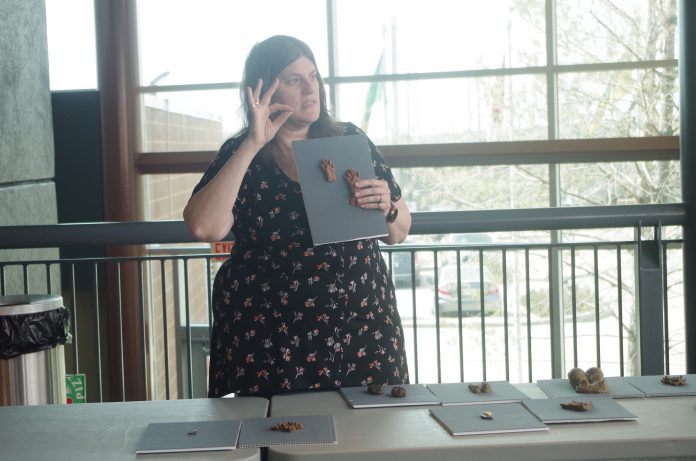
Marjorie D.L. Roden
Special to the Herald
When people think of “Colours of the Sash”, the first thing that comes to mind is the one-night concert featuring Metis performers, as curated by Donny Parenteau.
However, it was meant to be much more, and after 2 years’ worth of pandemic quarantining, it came out to a full one-day flourish of events at the E.A. Rawlinson Centre for middle-year students in Prince Albert and area.
This year’s event included musical expression, mini-king trapper events, animal tracking, and a look at the fur trade.
Molly Johnson and her Grade 5 students from Arthur Pechey School were one of the classes taking part in the event. She said ‘Colours of the Sash was a great learning opportunity for the students.
“It’s been really good,” she said. “I feel that it’s good for the kids to get some extra knowledge and to see it in real life instead of just in books. I think it’s been a great experience for them to see what the Metis culture is like.”
Jed Huntley was the teacher in charge of the trapping and fur trade exhibit. Armed with his Masters’ of Education degree, he kept the students’ full attention as he spoke about the fur trade. Huntley showed some of the tried and true technologies behind the fur trade to the very diverse crowds of children.
“I did my undergrad degree at SUNTEP in Regina, and there’s a huge cultural component to it,” Huntley explained. “I did learn, and re-learn, a lot of Indigenous history and gravitated towards it, then it carried over into cultural activities. I continued to pursue it, and carried on in graduate studies.”
By his own admission, Huntley is “a bit of a nerd” when it comes to history. He relished the opportunity to pass on some of that history to Prince Albert students.
“A large part of the fur trade was built on the backs of Indigenous peoples,” he explained. “The fur trade contributed greatly to the formation of Canada. It’s highlighting their role in Canada, and making the student aware of it.”
Juanita McKay-Raymond, one of the Teaching Assistants from Princess Margaret School’s grade 4 class, said students were excited to have learning opportunities outside of the classroom, something that hasn’t happened much over the past two years.
“The kids are really enjoying themselves,” she said. “It’s a lot of fun for them to interact and learn. This is one of the most exciting things that’s happened in a while, as we’ve not had a field trip since Covid.”
The animal-tracking display provided rubberized replicas of animal tracks, animal claws, and animal scat. Tracey Verishine, the instructor behind this was very enthusiastic.
“Karon from GDI asked me to do this, so I thought I would bring the fun stuff and bring replicated copies of the tracks and the feces,” she said. “We didn’t have any grocery stores long ago, but animals were what provided food, clothing, and shelter. The Metis people were a very resourceful people.”
Karon Shmon, the director of the Metis Culture and Heritage department at the Gabriel Dumont Institute, said the music portion was important, but there was so much more to learn about.
“We wanted another learning environment that we could tie in with curriculum objectives, and learning about the flora and fauna of Saskatchewan, and how important it was to the Indigenous peoples as a means of staying alive,” she explained.
When asked how the experience may help with future reconciliation, Johnson said it’s important to find ways of understanding that extend beyond textbooks.
“Seeing it with your own eyes is different than seeing it in a book,” she explained. “It’s great seeing other peoples’ perspective.”
“(It’s) just presenting it in a moreso hands-on experiential learning perspective, even though they are very short sessions,” Huntley added.
“Everything that we do should lead towards reconciliation, and it’s great to see this kind of diversity,” Verishine said.
McKay-Raymond agreed.
“Absolutely. As a Metis woman myself, I see this and it makes my heart feel good. To see more and more people learning about our culture, it’s wonderful.”
Given the strong start which this event had this year, chances are pretty high the two-day event might expand so that more school aged students could come through and benefit from learning about the early sciences, technologies, and histories of Western Canada.
editorial@paherald.sk.ca

